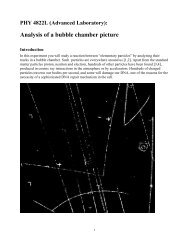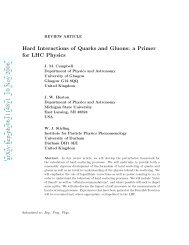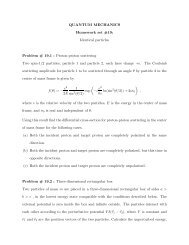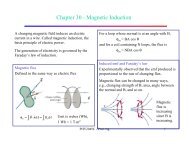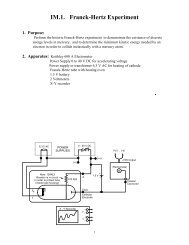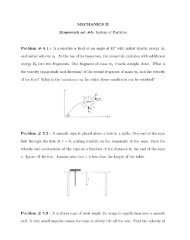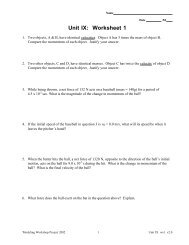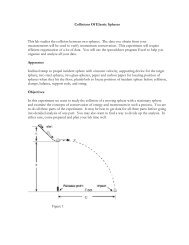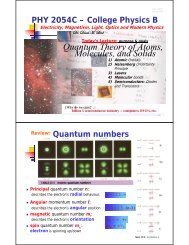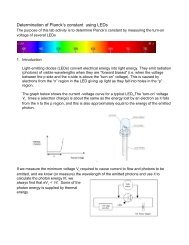Spring 2010 Solutions - FSU Physics Department
Spring 2010 Solutions - FSU Physics Department
Spring 2010 Solutions - FSU Physics Department
You also want an ePaper? Increase the reach of your titles
YUMPU automatically turns print PDFs into web optimized ePapers that Google loves.
<strong>Physics</strong> Qualifying ExaminationProblems 1–6 Thursday, January 7, <strong>2010</strong> 1–5 pmProblems 7-12 Friday, January 8, <strong>2010</strong> 1-5 pm1. Solve each problem.2. Start each problem solution on a fresh page. You may use multiple pages perproblem.3. At the top of each solution page put the problem number (1–12) and yourSocial Security number, but not your name or any other information.
Problem 1
Problem 2
Solution
Problem 3
Solution
Problem 4
Solution
Problem 5Suppose the Moon were to have the same mass as the Earth, and you are trying to throwone of your textbooks from the Earth to the Moon. With what minimum velocity must thebook leave the surface of the Earth? Neglect the relative motion of the Earth and Moon24and the Earth’s rotation. The mass of the Earth is M = 610 ⋅ kg , the radius of the Earth6is 6.4⋅10 m , and the distance from the center of the Earth to the center of the Moon is8R = 3.8⋅10m. Compare your answer to the escape velocity from Earth alone. TheEM−gravitational constant is G= 6.67⋅10Nm / kg11 2 2E
Problem 6
Solution
<strong>Physics</strong> Qualifying ExaminationProblems 1–6 Thursday, January 7, <strong>2010</strong> 1–5 pmProblems 7-12 Friday, January 8, <strong>2010</strong> 1-5 pm1. Solve each problem.2. Start each problem solution on a fresh page. You may use multiple pages perproblem.3. At the top of each solution page put the problem number (1–12) and yourSocial Security number, but not your name or any other information.
Problem 7
Solution
Problem 8A parallel plate capacitor with capacitance C is charged to a potential difference V and is thendisconnected from the charging source. The capacitor has an area A and a plate separationz. Neglect fringe effects at the edges of the plates.(a) What is the force acting on the upper capacitor plate as a function of plateseparation z?(b) Assume now that a glass plate of the same area A completely fills the spacebetween the plates. The glass has a dielectric constant κ. How much work isrequired to pull the glass plate out of the capacitor?SOLUTION:A parallel plate capacitor with capacitance C is charged to a potential difference V and isthen disconnected from the charging source. The capacitor has an area A and a plateseparation z.(a) What is the force acting on the upper capacitor plate as a function of plateseparation z?When the capacitor is disconnected from the charging source, thecharge on the capacitor plates stays constant. The force o thecapacitor plate can be written asdWF =−|dzQ = const.Where W is the stored energy in the capacitor. W is given byW21 Q=2 CThe capacitance C may be writtenCA= ε0zwhich can be substituted in to give2 21 Q 1 Q zW = =2 C 2 ε AInserting this into the force equation:02 2dW d ⎛1Q z ⎞ QF =− =− ⎜ ⎟= −dz dz ⎝2 ε0A ⎠ 2ε0A
and becauseQ=CV, this can also be writtenF2 2CV=−2εA0(b) Assume now that a glass plate of the same area A completely fills the spacebetween the plates. The glass has a dielectric constant κ. How much work isrequired to pull the glass plate out of the capacitor?When a glass plate is inserted between the two capacitor plates, thecapacitance and the potential between the plates will change(although the total charge will remain the same.) This will causethe Energy stored on the plates to also change.When the glass plate is between the capacitor plates:C'A= κε0zQV' = C'Without the glass plate between the capacitor plates:CThis means thatVV'VV'A= ε0zQV= CQ Q C' A A= ⎛ ⎜ ⎞ ⎟ ⎛ ⎜ ⎞ ⎟= =⎛ ⎜κε⎞ ⎛ 0 ⎟ ⎜ε⎞0 ⎟⎝C ⎠ ⎝C' ⎠ C ⎝ z ⎠ ⎝ z ⎠= κThe energy stored in the capacitor when the glass is between theplates is given by2 22Q Q z Q1 1 1W'i= = =2 C' 2κεA κ 2CAnd without the glass plateWf2 2 2Q Q z Q= 1 12 C= 2 ε A= 2CThe energy required to remove the glass plate isW= W −Wreq.f i002Q ⎛ 1 ⎞= ⎜1−⎟2C⎝ κ ⎠
Problem 9The Jet d'Eau, or water-jet, is a large fountain in Geneva, Switzerland,and is one of the city's most famous landmarks. Situated at the pointwhere Lake Geneva empties into the Rhone River, it is visiblethroughout the city and from the air, and is one of the largest fountainsin the world. It is designed to spray a column of water 140 meters intothe air and has a nozzle 5 cm in diameter at ground (or lake surface)level. The water pump is 6 meters below the ground level, and the pipeto the nozzle has a diameter of 15 cm. P atm = 101kPa. (Neglect theviscosity of the water and the air drag on the rising column of water inthe air.)(a) What is the velocity of the water leaving the nozzle (at ground level)?(b) What is the flow rate of the water just as it leaves the nozzle (in liters/sec)?(c) What pump pressure is required?Solution:…one of the largest fountains in the world. It is designed to spray a column of water 140meters into the air and has a nozzle 5 cm in diameter at ground (or lake surface) level.The water pump is 6 meters below the ground level, and the pipe to the nozzle has adiameter of 15 cm. P atm = 101kPa. (Neglect the viscosity of the water and the air drag onthe rising column of water in the air.)(a) What is the velocity of the water leaving the nozzle (at ground level)?We note that it is useful for the solution of this problem to obtain the state of the fluidat four distinct points along its path” (1) at the water pump, (2) just before the nozzle,(3) just outside the nozzle, and (4) at the top of the column of water. To solve this weneed a relation between the velocity of an incompressible fluid, its pressure at twoplaces, and the height difference between the two places. The relation is theBernoulli equation, which is a statement of conservation of energy in a fluid.1 2 1 2P1+ ρgy1+ 2ρv1 = P2 + ρgy2+2ρv2We also need the equation for continuity of the fluid, which is a statement of the lackof sources or sinks of fluid (or equivalently, of conservation of momentum in thefluid),vA= vA1 1 2 2where, for example, A 1 is the cross sectional area of the pipe at position (1).The parameters at each point along the fluid flow path:(1) At the water pump we have P 1 , y 1 = -6.0 m, v 1(2) Just before the nozzle we have P 2 , y 2 = 0, v 2(3) Just after the nozzle we have P 3 = P atm , y 3 = 0, v 3 = 9v 2 = 9v 1 , because the crosssectional area went down by a factor of nine going through the nozzle.(4) At the top of the column of water we have P 4 = P atm , y 4 = 140 m, v 4 = 0.
Use Bernoulli’s equation to work backward from the top of the column of water.1 2 1 2P3 + ρgy3 +2ρv3 = P4 + ρgy4+2ρv41 2ρ gy2ρ v =3 42v = 2gy3 4,which is just the speed required to project and object to height y 4 . Solving for thevelocity in terms of known parameters gives:3 42( )( )v = 2gy = 2 9.8 m / s 140mv3= 52.4 m/s(b) What is the flow rate of the water just as it leaves the nozzle (in liters/sec)?The flow rate is volume/time, or V/Δt = AΔx /Δt = A (Δx /Δt) = Av which is just theterms on each side of the continuity equation.−2 2( ) ⎡πrate = v1A1 = 52.4 m / s ⎣ (2.5x10 m)⎤⎦3rate = 0.103 m / s = 103 liters / s(c) What pump pressure is required?Working backwards, we have1 1P2 + gy2 +2ρv2 = P3+ gy3+22 2ρ ρ ρv321 ⎛v3⎞ 12+2ρ=3+2ρ2P ⎜ ⎟ P v 3⎝ 9 ⎠1 2 1v3P2 = Patm+2ρv3−2ρ ⎛ ⎜ ⎞⎟⎝ 9 ⎠1 2 12P1802= P + ρ 1− v3= P + ρ v3atmP = P + gy2 ( 81) atm 2 ( 81)80( ) ρ2 atm 81 4Finally, we can obtain the pressure at the pump, P 1 , simply by adding this pressuredue to the 6 meter column of water (since v 1 = v 2 ),1 2 1 2P1+ ρgy1+ 2ρv1 = P2 + ρgy2+2ρv2P+ ρgy = P + ρgy 1P = P + ρg y − y1 1 2( )1 2 2 1280( ) ( )P1 = Patm + ρg⎡ 81y4y2 y ⎤⎣+ −1 ⎦
1101 1000 kg ⎛9.8 m ⎞P = kPa +803 ⎜ 2 ⎡ ( 81 ) 140m + 6m⎤m ⎝ s⎟⎣⎠⎦
Problem 10Light of wavelength 300 nm strikes a metal plate, producing photoelectrons that movewith speed of 0.002c.(a) What is the work function of the metal?(b) What is the critical wavelength for this metal, so that photoelectrons are produced?(c) What is the significance of the critical wavelength?SolutionLight of wavelength 300 nm strikes a metal plate, producing photoelectrons thatmove with speed of 0.002c.In the photoelectric effect the incoming photons remove electrons from the target.There is a minimum energy required to remove an electron from the interior of asolid to a position just outside. This minimum energy is called the work functionΦ. The relation between the energy of photon Eγ , the energy of electron Ee, andthe work function Φ is given byE = Ee + Φ (1)Note that energy of electron Ee is equal to the kinetic energy of electron, sincewhen electron is outside the solid it is not affected by any potential. In other wordselectron will be considered as a free particle.(a) What is the work function of the metal?Use Eq.1, since the speed of the electron is much less than speed of the lightwe do not need to use the special relativity formula for the kinetic energy.Ee = (1/2)mv 2 (2)= (1/2) (511keV/c 2 ) (0.002c) 2 =1.022eV (3)Eγ = hυ = hc/λ (4)= (1420 eV nm/300 nm) = 4.13 eV (5)Φ = Eγ – Ee (6)= 3.111 eV (7)(b) What is the critical wavelength for this metal, so that photoelectronsare produced ?The critical wavelength is defined as the wavelength for photons which removeelectrons from interior of a solid to a position outside the solid. Inthis case the kinetic energy of electrons outside the solid is equal zero Ee = 0.Using the Eq.1 and the results from part (a) we obtain
Eγ = Φ (8)hc/ λcritical = Φλcritical = hc/Φ (9)λcritical =1420 eV/3.111 eVλcritical = 398.6 eV (10)(c) What is the significance of the critical wavelength?Photons with a lower wavelength than the critical wavelength cannot produce photoelectrons.This led Einstein to the postulation of quantized energy for the electromagneticfields.
Problem 11The ground level of the neutral lithium atom is doubly degenerate (that is, d0 = 2). Thefirst excited level is 6-fold degenerate (d1 = 6) and is at an energy 1.2 eV above theground level.(a) In the outer atmosphere of the Sun, which is at a temperature of about 6000 K, whatfraction of the neutral lithium is in the excited level? Since all the other levels of Li are ata much higher energy, it is safe to assume that they are not significantly occupied.(b) Find the average energy of Li atom at temperature T(again, consider only the ground state and the first excited level).(c) Find the contribution of these levels to the specific heat per mole, CV, and sketch CVas a function of T.Solution(a) If the ground level energy is defined as zero and E is the energy ofexcited level:Z = Σ i d i exp(-βε i ) = 2 + 6 exp (−βΕ)The probability that the atom is in its excited level:P(E) = 6 exp(−βΕ) / Ζ= exp(−βΕ)]/ [2 + 6 exp(−βΕ)]= 3 / (3 + exp(βΕ)Since E = 1.2 eV, T = 6000K (~0.5 eV), βE = 2.32, exp(βE ) ≈ 10we get: P(Ε ) = [3/ (3+ 10)] = 0.23(b) The average energy per atom is: = (1/Ζ)(δΖ/δβ) = [(ε) 6 exp(−βε )] / [2+6 exp(−βε)] = [3ε /(exp(βε) + 3)](c) The specific heat is:C v = [δ/δΤ] v = [-3ε x ε exp(βε)( δβ/δT)] / [exp(βε) + 3] 2= [3k B (βε) 2 exp(βε)] / [exp(βε) +3] 2
Problem 12
Solution



